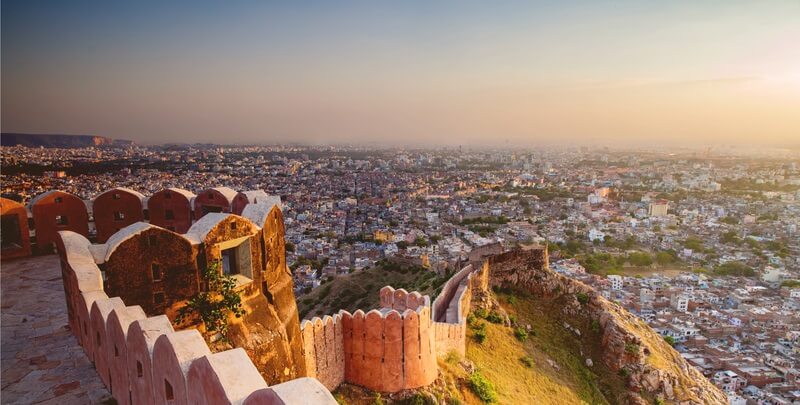Indian job interview? Here are some tips
India is an ethnically diverse and culturally vibrant country. If you’re thinking about moving to India you'll probably need to find a job, and with a large...

If you have ties to India, you may be thinking of spending your retirement there. After all, what’s better than spending as much time as you can with your loved ones?
But that’s not all.
The cost of living in India is quite low, which makes it possible to afford a more comfortable lifestyle than you could elsewhere.
Sounds good, right?
Let’s have a look at the costs involved.
According to Fidelity Investments, one of the largest financial services groups in the world, you should save up to about eight times your latest salary to fund your retirement. This should provide you with about 85% of your pre-retirement income throughout your retirement.
That said, how much money you’ll actually need depends on the kind of lifestyle you plan to live. Certain places will also be more expensive than others to live in.
Generally speaking, a “comfortable” lifestyle will include at least some of the following:
The following table can give you an idea of the cost of living in Delhi, a popular destination for many expat retirees, in 2017:
| Average monthly expenses | Cost (INR) |
|---|---|
| Monthly rent - 3 bedroom apartment in the city centre (85m²) | 41,245 |
| Utilities (electricity, climate control, gas, refuse) | 3,917 |
| Internet | 1,392 |
| Maid (monthly wage) | 8,000 |
| Groceries | 2,855 |
| Dining out for 2 people (mid-range restaurant) | 1,000 |
| Healthcare | 15,247 |
| Fitness / social club membership | 2,077 |
| Other expenses | 6000 |
| Monthly Total: | 81,733 |
Details from Numbeo and Quora as at April 2017.
Most prices are more or less the same in other cities, such as Bangalore and Calcutta. However, rental prices in Mumbai can be shockingly expensive. Renting a three bedroom apartment in the city centre could cost as much as INR 90,000 a month.
You can’t buy a dishwasher in India, and clothes are also usually washed by hand. Because of this, most households have a kaamwali bai (maid) to help with cooking and other chores.
If you already own a property, you could live very comfortably on INR 75,000 a month. Bear in mind, though, that your savings need to grow with inflation.
While foreigners can inherit from an Indian resident, they cannot purchase property. You can however lease a property for up to 5 years, after which you’ll need to renew the lease.
Citizens of certain nationalities are also disqualified from inheriting property unless they get permission from the Reserve Bank of India.
If you’re planning to retire in India, you need to be aware of two important factors:
Depending on your status, you can apply for one of three types of visa as a retiree.
Let’s have a look at each.
To qualify for this visa, you need to satisfy one of these requirements:
As a PIO, you can apply for a five year entry visa. You’ll need to renew it every year, and reapply once it expires.
If you’re an Indian citizen living abroad, you can apply for a multiple entry, lifelong visa. This will give you the right to stay in India for as long as you like, even if you have dual citizenship in another country.
If you have no ties to India, getting a visa is a difficult process.
As a retiree, your only option is a tourist visa. This will only allow you to stay in India for up to 180 days at a time. You’ll need to stay out of India for two months before you can reapply.
Because a renewal can only be processed outside of India, you’ll need to factor in the cost of international flights at least twice a year when working out your pension allowance.
To apply for your visa, contact the Indian Embassy in your home country. The Indian government has also approved the following official outsourcing companies in the US, UK, Canada and Australia:
You’ll need to fill in the application form, and also submit a number of documents.
The documents required will depend on your nationality, citizenship and the type of visa you’re applying for. The Indian Embassy in your home country can give you more information about the specific application requirements for your individual situation.
A multiple entry visa from the UK costs £109.44 for a one-year visa, and £309.44 for a five-year visa.
In the US, you can get a five or ten year multiple entry visa for $153. Each entry is for a maximum of 180 days.
In India, you can be taxed either as a resident or as a non-resident.
You’re taxed as a non-resident if you’re physically present in India for less than 182 days in a given tax year, which runs from the 1st April to the 31st March. If you’re a foreigner on a tourist visa, this is how you’ll most likely be taxed.
Non-residents pay tax on a sliding scale as follows:
| Income (INR) | Rate (%) |
|---|---|
| Up to 250,000 | 0 |
| 250,001 - 500,000 | 10 |
| 500,001 - 1,000,000 | 20 + INR 25,000 fee |
| 1,000,001 and up | 30 + INR 125,000 fee |
Data from www.incometaxindia.gov.in as of April 2017.
You’ll also have to pay a 10% surcharge if your income exceeds INR 10,000,000.
As a non-resident, you’ll only be taxed on your Indian income. This means you won’t pay tax on your foreign pension. However, you'll have to pay tax on any interest you earn in India.
As an Indian resident, your tax situation will depend on whether you’re considered ‘resident’ or ‘not ordinarily resident’.
You may still be treated as a non-resident, even though you’re physically present in India for more than 182 days in a given tax year, if you meet one of the following conditions:
In this case, you’ll be taxed as a non-resident.
If you’re an Indian resident, you’re taxed on all your worldwide income at the following rates::
| Income (INR) | Rate (%) |
|---|---|
| up to 250,000 | 0 |
| 250,001 - 500,000 | 10 |
| 500,001 - 1,000,000 | 20 |
| 1,000,001 and up | 30 |
Details from www.incometaxindia.gov.in as of April 2017.
Luckily, the tax free band for people over 60 is INR 300,000; while the tax free band for people over 80 is INR 500,000.
As a general rule, your worldwide taxable income includes your foreign pension. However, depending on where your pension comes from, it may qualify for special tax treatment.
UK pensions, for example, can be transferred under a special system called Qualifying Recognised Overseas Pension Schemes (QROPS). These are schemes approved by the HMRC which help you get your pension as tax efficiently as possible wherever you are in the world.
If you receive a pension from the US, you’ll need to fill in form W-8BEN and submit it to your pension provider. This confirms you’re not a resident in the US for tax purposes.
Public health care in India is free, and most Indian doctors and nurses speak fluent English. However, public hospitals are often overcrowded, and the care on offer may not be up to the standard you’re used to in your home country.
Fortunately, there are private hospitals in all major cities, and they offer an excellent standard of care. Private health insurance is also very affordable, so many expat retirees choose this option.
Many health insurance providers in India offer policies made specifically for senior citizens. You may qualify for one of these policies if you’re as young as 46 years old. However, some providers may also have an upper age limit above which you won’t qualify.
The top providers of health insurance for senior citizens in India are:
These providers all have broadly similar products.
Basic cover includes hospitalisation and treatment costs, medical expenses incurred before and after your hospital stay and ambulance charges.
You may also be able to get cover for pre-existing conditions. However, terms and conditions will apply. You should always read your policy document carefully, especially the fine print, otherwise you may be in for a nasty surprise.
The cost of a health insurance policy will depend on a number of factors, including your age, general health, the sum insured, the level of cover you choose and even your location.
A basic health insurance package for a 60 year old living in Delhi with a sum insured of INR 100,000 starts at around INR 14,647 per year.
If you’re an Indian citizen over 60, you’re eligible for a tax rebate of up to INR 30,000 per year on your insurance premium.
India has a managed floating exchange rate, which means that, most of the time, the value of the Rupee may go up or down depending on the state of the international market. The exchange rate may affect the value of your pension positively or negatively, depending on what the rate is on the day of your transfer.
You can deal with the exchange rate in one of two ways.
Your first option is to transfer your entire pension into an Indian bank account in one go. That way, you’ll only have to deal with the exchange rate once.
This is a good option if you plan to move to India permanently and don’t have any expenses in your home country.
You won’t have to pay tax on this money. However, may have to pay tax on any interest you earn, depending on the type of bank account you have. Non-resident external accounts are entirely tax free, but non-resident ordinary accounts and resident accounts aren’t.
Another alternative is to keep your pension in your home country and transfer a given amount of money to India every so often, much in the same way as you would pay yourself a salary.
This could be a good choice if you live primarily in India but travel back home often. The value of the Rupee is relatively low compared to other major currencies such as the US Dollar, which means you can often get a very favourable exchange rate.
Whichever option you choose, you should beware of hidden fees and unfavourable exchange rates.
Always make sure you’re paying the mid-market rate when you’re making a transfer. This is the lowest and fairest exchange rate possible.
And be skeptical of claims of “no fees” or “zero commission”. There’s no such thing as a fee-free international transfer, so keep your eyes open and look for the best deal possible. Also, a good option to consider using is Wise, as they not only use the mid-market rate but they also save you on international transfer fees by using local transfers on the sending and receiving end.
*Please see terms of use and product availability for your region or visit Wise fees and pricing for the most up to date pricing and fee information.
This publication is provided for general information purposes and does not constitute legal, tax or other professional advice from Wise Payments Limited or its subsidiaries and its affiliates, and it is not intended as a substitute for obtaining advice from a financial advisor or any other professional.
We make no representations, warranties or guarantees, whether expressed or implied, that the content in the publication is accurate, complete or up to date.

India is an ethnically diverse and culturally vibrant country. If you’re thinking about moving to India you'll probably need to find a job, and with a large...

The food alone is reason enough to plan a trip to India. Add in a booming technology sector, bustling cities and heaps of historical and religious monuments,...

India is a country packed with opportunities - so if you live or work there, and plan to stay for the long term, then seeking Indian citizenship makes a lot...

Having a baby is one of the most exciting times of your life. But there are many aspects that can feel daunting, especially if you’re an expat living abroad....

With a population of more than 1.3 billion, it’s no surprise that India runs the largest national school system in the world. While it’s not often recognized...

Getting legally married in India isn’t a simple process. Between a lengthy wait time, nuanced legal customs and a plethora of details to consider. However,...